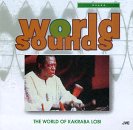| All Artists: Kakraba Lobi Title: Ghana: World of Kakraba Lobi Members Wishing: 0 Total Copies: 0 Label: Jvc/Sire Release Date: 1/30/1995 Genres: International Music, Pop Style: Africa Number of Discs: 1 SwapaCD Credits: 1 UPC: 009119501422 |
Search - Kakraba Lobi :: Ghana: World of Kakraba Lobi
 | Kakraba Lobi Ghana: World of Kakraba Lobi Genres: International Music, Pop
|
Larger Image |
CD Details |
CD ReviewsSoulful virtuosity on six different instruments Phil Rogers | Ann Arbor, Michigan | 05/28/2003 (5 out of 5 stars) "Mr. Lobi here plays 9 solo pieces with frequently added vocals demonstrating acutely both extreme virtuosity and poetically adept musicality. He performs on two different types of xylophone, plus the well-known talking (tension-type) drum, the large snare drum normally used to support the talking drum, a Ghanian bamboo flute, and the mouth bow. Daybreak [7:09] - 14-key gourd-resonated curved-frame xylophone (= gyil)
Entrance Song [2:35] - bamboo flute (= atentenben) Song of the Vampire [3:47] - mouthbow solo Song of the Celebration [7:04] - drum solo with voice: large cylindrical snare drum (= gungon or brekete), normally utilized to accompany talking (tension) drum The Bewildered Child [5:18] - 8-key non-resonated straight-frame xylophone Don't Mind the Body, Mind the Engine [7:21] - drum solo with lengthy vocal sections: talking "tension" drum (= luna) Song of Military Advance and Song Condolence [8:27] - gyil Unite Africa [5:15] - gyil Gurigurimaniyon [9:24] - gyilSelections #1 and #'s 7-9 are played on the 14-key xylophone known variously as the gyil, kogyil, bogyil, gyile, etc., which is indigenous to the region of NW Ghana and neighboring areas of Burkina Faso and Ivory Coast populated by the Dagara, Lobi and Sisaala ethnic aggregations. (Sisaala instruments have as many as 17-18 keys, but otherwise are constructed the same as those from the Dagaara and Lobi enclaves.) This relatively large instrument is different sounding than the more familiar balafon, which holds sway further west in large areas of Mali, Senegal, Guinea, and the Gambia. The wood used for balafon keys comes from a different kind of tree; plus there are 7 keys per octave (usually 19-22 keys altogether); gyils are tuned with only 5 notes per octave. Because gyils have at least 3 buzzing resonators per gourd/key, they generally buzz louder and sustain longer than do balafons, which typically have either 1 or 2 buzzers per gourd/key, and thicker keys for an overall sweeter sound. The balafon repertoire is heavily influenced by Islamic music; gyil music (with its pentatonic scale) sounds entirely indigenous. It is very rhythmically interlocking, and melodically inventive.Mr. Lobi, who's been around a very long time, might be the best in the world on this instrument (but be sure to check out Bernard Woma, who is in his 30's). One of the nicer things on this CD (if you're learning to play the gyil) is that the instrument has been recorded in stereo, the microphones placed right where you'd be hearing if you were playing. So you can relatively easily sort out what's going on, a little at a time. It still goes by very, very quickly - but because of the left-to-right orientation, the sound's not smushed together like it would be if recorded from 10 feet in front of the instrument, the way an audience would hear it. You might have to reverse the stereo field left to right (if your stereo receiver doesn't have this function, just temporarily switch the speaker wires) - most gyil players (but not all) situate themselves with the higher keys to their left. Here the microphones were placed with higher keys are on the left. If all you've ever heard of the mouthbow is from Buffy Sainte-Marie, you're really in for a treat. Mouthbows are indigenous in all parts of Africa, as well as many parts of the world, but I've never heard anyone play like this man. The usual technique is to pluck the string, or strike it with a stick, while rhythmically adding tonal (higher, lower, etc.) notes by opening and closing one's mouth, which acts as the resonator. Mr. Lobi goes one better by using the mouth tones to add polyrhythms to the stock rhythm created by the action of plucking/striking. And they're strong and beautiful - your eyes will get bigger and your head may start spinning!What's to say? Kakraba Lobi is equally inspiring and accomplished on the various solos he performs on the other four instruments. The track with the smaller, more quiet/dark/lyrical sounding log xylophone is particularly touching. The engineer(s) on this project used great microphones and other equipment. Their microphone placement was matchless - the sound is so good it makes me want to weep . . . well, sort of. Skeleton Bibliography: Larry Dennis Godsey. 'The Use of the Xylophone in the Funeral Ceremony of the Birifor of Northwest Ghana". Lynne Jessup. 'The Mandinka Balafon: an Introduction with Notation for Teaching'. David Locke & Godwin Agbeli. 'Drum Damba: Talking Drum Lessons'. Mary Hermaine Seavoy. "The Sisaala Xylophone Tradition". Malidoma Patrice Some. 'Ritual: Power, Healing and Community: the African Teachings of the Dagara'. Mitchel Strumpf. 'Ghanaian Xylophone Studies'. Trevor Wiggins and Joseph Kobom. 'Xylophone Music in Ghana'.Skintight Discography/Videography: Lynne Jessup. 'The Mandinka Balafon' and 'Teaching Mandinka Balafon' [2 cassette tapes]. Joseph Kobom. 'Xylophone Music in Ghana' [CD] Abubakari Lunna. 'Drum Damba' [CD] Bernard Woma. 'Dagara Bewaa Culture Group Featuring Bernard Woma' [videotape] Bernard Woma. 'Dagara Yielu' [CD]" |

 Track Listings (9) - Disc #1
Track Listings (9) - Disc #1